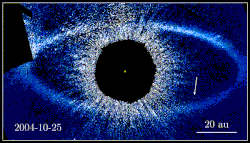Over the past 25 years, several thousand planetary systems around other stars have been discovered and characterized around pre-main-sequence and main-sequence stars, encompassing many sub-disciplines such as planet formation, circumstellar disks, dynamics, atmospheric chemistry, demographics, astrobiology, and even the search for techosignatures. Our focus is on observational studies of dusty debris disks, wide-separation gas giant planets, and circumplanetary rings using a variety of resources, such as the Hubble Space Telescope, the Gemini Planet Imager, VLT/SPHERE, ALMA, Gaia, and eventually JWST and WFIRST. Data from these observatories provide unique and fundamental information, such as:
- The masses of exoplanets, by analyzing how bright they appear and the properties of their orbits.
- Their composition, by analyzing the color of thermal emission from the planet, or by obtaining a spectrum.
- The origin of exoplanets, by comparing their current observed properties with simulations of how planets form in a circumstellar disk and subsequently evolve.
Ultimately, this research provides an empirical notion of how common or rare our own planetary system must be in our own galaxy and throughout the universe.
Recent selected publications:
- Damaso, M. Del Sordo, F., Anglada-Escude, G., et al. "A low-mass planet candidate orbiting Proxima Centauri at a distance of 1.5 AU", 2020, Science Advances, 6
- De Rosa, R. and Kalas, P. "A Near-coplanar Stellar Flyby of the Planet Host Star HD 106906”, 2019, AJ, 157, 125
- MacGregor, M.A. Matra, L., Kalas, P., et al. "A Complete ALMA Map of the Fomalhaut Debris Disk”, 2017, ApJ, 842, 8
- Kalas, P., Graham, J.R., Fitzgerald, M.P, & Clampin, M. "HST/STIS imaging of Fomalhaut: New main belt structure and confirmation of Fomalhaut b's eccentric orbit”, 2013, ApJ, 775, 56
- Kalas, P., Graham, J.R., Chiang, E., et al. "Optical Images of an Exosolar Planet 25 Light-Years from Earth”, 2008, Science, 322, 1345

